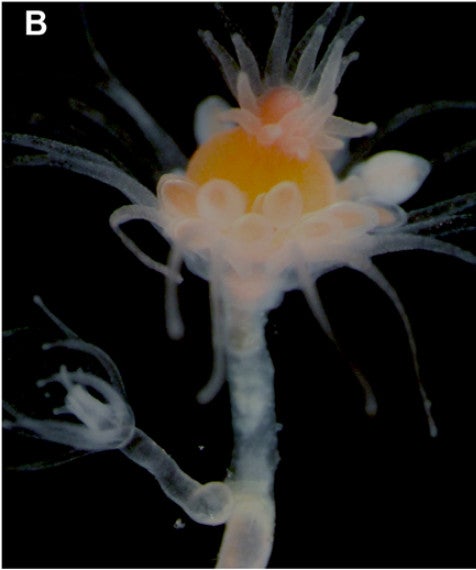This article was published in Scientific American’s former blog network and reflects the views of the author, not necessarily those of Scientific American
Although many animals live in colonies, most have a “Hard No” policy on members who are not clones or close relatives. But not Ectopleura larynx. It is totally cool with grafting strangers to its body.
At least, that’s according to a study in Evolution Letters in June by scientists at the University of Kansas. They claim to have found compelling genetic evidence that at least a few members of each colony of the little marine hydrozoan were unrelated to the organism that founded it, making them chimeras. This is particularly odd when you consider that this is the equivalent of welding a random passerby to yourself, such that you will now share a skin, stomach, and music playlist, whether you like it or not.
But it appears the pressures of life on a space- and resource-limited shallow-water habitats in the North Atlantic Ocean have overridden concerns about such niceties here. Being bigger ensures you get to take up more space, and more polyps not only mean more mouths to feed, but also more food-targeting tentacles with which to snatch it.
On supporting science journalism
If you're enjoying this article, consider supporting our award-winning journalism by subscribing. By purchasing a subscription you are helping to ensure the future of impactful stories about the discoveries and ideas shaping our world today.
The evidence for the grafting of strangers in colonies of Ectopleura larynx included otherwise hard-to-explain anomalies like polyps that contained two copies of gene variants that were not present in other polyps in the colony. Most animals have two copies of each gene, one inherited from each parent. Two unique versions in one organism – biologists call them alleles – implies that neither a simple mutation nor sexual reproduction could easily explain their presence. More complex measures of genetic relatedness employed by the scientists confirmed there were a few strangers mixed into a colony dominated by clones and parents/offspring/siblings.

A young polyp soon after its attachment to an older female colony. Credit: Chang et al. 2018
Why, one might ask, would any organism be willing to tolerate such stranger-grafts when it could just bud indefinitely like a proper cnidarian? Ah, there’s the rub. At some point in the past, Ectopleura lost its powers of cloning. It has regained a limited ability to bud a few times early in life, and also in response to grazing injury. But for the most part, if it wants to get bigger, it’s got to recruit. And apparently, it pays to not be too picky about it. Is it ideal? No. Is it effective? Yes.
Another interesting question is whether this open-door colony policy will cause upsetting genetic conflicts down the road. For instance, both the tunicate Botryllus schlosseri – a baggy colonial marine animal closely related to vertebrates – and the cellular slime mold Dictyostelium discoideum – a bag of recruited amoebas – experience reproductive parasitism (a.k.a. cheating) as a result of similar cohabitation arrangements.
In these organisms – which also have laissez-faire attitudes toward “self” and “individual” -- one or a few genetically distinct individuals monopolize reproduction at the expense of others without doing their fair share of the chores. It’s also possible that even if all polyps have access to reproduction, fights may erupt over which gametes get which resources.
The authors do note that the genetic diversity of Ectopleura larynx is relatively low compared to similar cnidarians and invertebrates. As such, it’s possible that even “strangers” are similar enough to host polyps to escape a “non-self” immune response and that their contributions to colony enlargement outweigh any genetic purity concerns.
Hydrozoans also continually create gametes from a population of stem cells, so it is possible any polyp may reproduce. That certainly seems to me like it would make the chimerism observed in Ectopleura larynx easier. Otherwise, wouldn’t polyps evolve a mechanism to prevent fusion to colonies that will be a reproductive dead end? There is likely one thing Ectopleura larynx still has a "Hard No" policy on: celibacy.
Reference
Chang, E. Sally, Maria E. Orive, and Paulyn Cartwright. "Nonclonal coloniality: Genetically chimeric colonies through fusion of sexually produced polyps in the hydrozoan Ectopleura larynx." Evolution Letters 2, no. 4 (2018): 442-455.